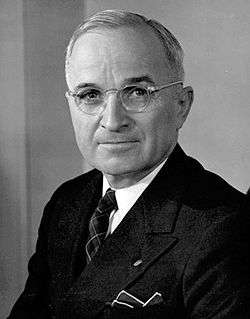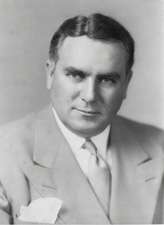1952 Democratic National Convention
|
1952 presidential election | |
|
Nominees Stevenson and Sparkman | |
| Convention | |
|---|---|
| Date(s) | July 21–26, 1952 |
| City | Chicago, Illinois |
| Venue | International Amphitheatre |
| Candidates | |
| Presidential nominee | Adlai Stevenson of Illinois |
| Vice Presidential nominee | John Sparkman of Alabama |
The 1952 Democratic National Convention was held at the International Amphitheatre in Chicago, Illinois from July 21 to July 26, 1952, which was the same arena the Republicans had gathered in a few weeks earlier for their national convention. Four major candidates sought the nomination: U.S. Senator Estes Kefauver of Tennessee, Governor Adlai E. Stevenson, II, of Illinois, Senator Richard Russell of Georgia and Averell Harriman of New York.
Democratic platform
The Democrats favored a strong national defense, collective security against the Soviet Union, multilateral disarmament, repeal of the Taft-Hartley Act, equal employment opportunities for minorities and public assistance for the aged, children, blind, and the disabled, expansion of the school lunch program, and continued efforts to fight racial discrimination.
Movement to draft Stevenson
Governor Stevenson, who stated that he was not a presidential candidate, was asked to give the welcoming address to the delegates. He proceeded to give a witty and stirring address that led his supporters to begin a renewed round of efforts to nominate him despite his protests. After meeting with Jacob Arvey, the boss of the Illinois delegation, Stevenson finally agreed to enter his name as a candidate for the nomination. The party bosses from other large Northern and Midwestern states quickly joined in support. Kefauver led on the first ballot but had far fewer votes than necessary to win. Stevenson gradually gained strength until he was nominated on the third ballot. The convention then chose Senator John Sparkman of Alabama, a conservative and segregationist, as Stevenson's running mate. Stevenson then delivered an eloquent acceptance speech in which he famously pledged to "talk sense to the American people."[1]
Democratic candidates
-
.jpg)
Senator
Estes Kefauver
of Tennessee
(Withdrew after 3rd Ballot) -

Senator
Richard Russell Jr.
of Georgia
(Withdrew after 3rd Ballot) -

Fmr. Sec. of Commerce
W. Averell Harriman
of New York
(Withdrew before 3rd Ballot) -

Senator
Robert S. Kerr
of Oklahoma
(Withdrew before 2nd Ballot) -

President
Harry S. Truman
Of Missouri
(Declined March 28, 1952) -

Governor
Paul A. Dever
of Massachusetts
(Withdrew before 3rd Ballot) -

Senator
Hubert Humphrey
of Minnesota
(Withdrew before 2nd Ballot) -

Senator
J. William Fulbright
of Arkansas
(Withdrew before 2nd Ballot) -

Senator
Brien McMahon
of Connecticut
(Withdrew June, 1952)
(Died July 28, 1952) -

Senator
James E. Murray
of Montana
(Withdrew before 2nd Ballot) -
Senator
Paul Douglas
of Illinois
(Declined - Aug. 15, 1951) -

Associate Justice
William O. Douglas
of New York
(Declined - Jan. 13, 1952)
Presidential balloting
Kefauver had the most delegates after the first round, but then President Truman weighed into the battle in favor of Stevenson. He persuaded Harriman to drop out and endorse the Illinois governor, thereby pre-empting support for Kefauver and Russell, whom Truman opposed. The President believed that nominating a Southern candidate from a state where Jim Crow laws were in force would forfeit potential support for the Democratic party from African-American and Northern white voters.
Stevenson was nominated on the third ballot. It was the last nomination contest of either major U.S. political party to require more than one round of voting to nominate a presidential candidate to date.[2]
The following table from Richard C. Bain and Judith H. Parris, Convention Decisions and Voting Records,
| Presidential Balloting | |||||||
|---|---|---|---|---|---|---|---|
| Ballot | 1st Before Shifts | 1st After Shifts | 2nd Before Shifts | 2nd After Shifts | 3rd Before Shifts | 3rd After Shifts | Unanimous |
| Estes Kefauver | 300.5 | 340 | 362 | 361 | 279.5 | 275.5 | - |
| Adlai Stevenson | 248.5 | 273 | 329.5 | 324.5 | 613 | 617.5 | 1,230 |
| Richard Russell Jr. | 267.5 | 268 | 294 | 294 | 261.5 | 261 | - |
| W. Averell Harriman | 126 | 123.5 | 121.5 | 121.5 | - | - | - |
| Alben W. Barkley | 49.5 | 48.5 | 81 | 81 | 67.5 | 67.5 | - |
| Robert S. Kerr | 69 | 65 | 5.5 | 5.5 | - | - | - |
| Paul A. Dever | 37.5 | 37.5 | 30.5 | 30.5 | 0.5 | 0.5 | - |
| G. Mennen Williams | 40.5 | - | - | - | - | - | - |
| Hubert Humphrey | 26 | 26 | - | - | - | - | - |
| J. William Fulbright | 22 | 22 | - | - | - | - | - |
| Brien McMahon | 16 | - | - | - | - | - | - |
| James E. Murray | 12 | 12 | - | - | - | - | - |
| Harry S. Truman | 6 | 6 | 1 | 6 | - | - | - |
| Oscar R. Ewing | 4 | 4 | 3 | 3 | 3 | 3 | - |
| Paul Douglas | 3 | 3 | 3 | 3 | 3 | 3 | - |
| William O. Douglas | 0.5 | 0.5 | - | - | - | - | - |
| Not Voting | 1.5 | 1.5 | 1.5 | 1.5 | 2.5 | 2.5 | - |
Vice-presidential selection
Among those considered for the VP spot by Stevenson included:
-

Vice President Alben Barkley of Kentucky
-
.jpg)
Senator Estes Kefauver of Tennessee
-

Senator Mike Monroney of Oklahoma
-

Senator Richard Russell of Georgia
-

Senator John Sparkman of Alabama
After the delegates nominated Stevenson, the convention then turned to selecting a vice-president. The main candidates for this position were Kefauver, Russell, Barkley, Senator John Sparkman, and Senator A. S. Mike Monroney. After narrowing it down to Senator Sparkman and Senator Monroney, President Truman and a small group of political insiders chose Sparkman, a conservative and segregationist from Alabama, for the nomination. The convention largely complied and nominated Sparkman as Stevenson's running mate, though nominations were made for two other candidates for the Vice Presidency, Vice Chairwoman of the Democratic National Committee India Edwards of California, and District Judge Sarah T. Hughes of Texas. Both withdrew their names in favor of Sparkman. Stevenson then delivered an eloquent acceptance speech in which he famously pledged to "talk sense to the American people."
Election outcome
Adlai Stevenson and running mate John Sparkman lost the election to Dwight D. Eisenhower and Richard M. Nixon on November 4, 1952. Despite the defeat, Stevenson was four years later again selected as the Democratic presidential nominee at the 1956 Democratic National Convention, with Kefauver as his running mate.
References
- ↑ "Adlai Stevenson (1900-1965)". National Park Service. Retrieved 2009-08-19.
- ↑ Bain, Richard C., and Parris, Judith H. (1973). Convention Decisions and Voting Records. Washington, D.C.: Brookings Institution. pp. 286–292.
External links
- Democratic Party Platform of 1952 at The American Presidency Project
- Stevenson Acceptance Speech at The American Presidency Project
| Preceded by 1948 |
Democratic National Conventions | Succeeded by 1956 |


